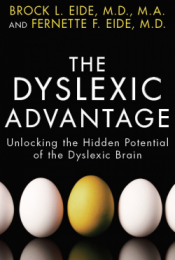Review of The Dyslexic Advantage by Brock and Fernette Eide

Review by Kathy Kuhl
Dyslexia, an advantage? I have heard people say that disabilities were really advantages. I thought they were in denial or confused. I agree that disabilities and challenges can benefit us: I’ve seen my son’s learning disabilities make him more compassionate and persevering. But I wouldn’t have called dyslexia in itself an advantage, any more than I would have called multiple sclerosis an advantage.

An advantage?
It looks like I was wrong. In their latest book, Drs. Brock and Fernette Eide lay out the case that the symptoms of dyslexia are very commonly and closely linked with groups of specific strengths. Their book, The Dyslexic Advantage, doesn’t begin by teaching you how to help dyslexics read and spell. Instead, it shows you how to think about and develop the impressive collections of talents that accompany dyslexia, “how to be better at being dyslexic.” The authors developed these concepts partly by studying successful dyslexic people, and by years of clinical work with dyslexic children and their families. Their book also helps you understand dyslexia better: why, for instance, dyslexics have trouble with tasks that have nothing to do with phonics or reading, like motor control, processing speed, and working memory.
Dyslexia is five times more common among successful entrepreneurs than it is among the population at large. It’s also unusually common among successful people who show strengths in four basic areas:
- Material reasoning: engineers, architects, builders, biochemists, inventors, geophysicists, robotics experts;
- Interconnected reasoning: ecosystem expert John Muir Laws, former Google CIO Douglas Merrill;
- Narrative reasoning: successful screenwriters Pulitzer winners, and best selling novelists including Ann Rice.
in other fields: innovative thinkers, - Dynamic reasoning: The ability to imagine past state or predict the future state of complex systems by combining data and principles to conjecture wisely: entrepreneurs, geologists and other researchers who need to visual complicated processes to find solutions.
For a glimpse of what they are talking about, watch the authors give this TedxTalk, “The turkey and the crow,” here or below. They contrast the people who are good at learning to do tasks fast and automatically, versus people who are good at innovating.
Don’t skip ahead
The last third of the book is the practical part some of you will be tempted to skip to. (Resist the temptation.) Rest assured is is full of terrific, specific suggestions on reading and writing, then more specifics on elementary and middle school years, high school and college, and the workplace.
I highly recommend this book, and the authors’ website.
Buying it through this link will tell Amazon to send a portion of the price to support this website. Thank you.



One Comment